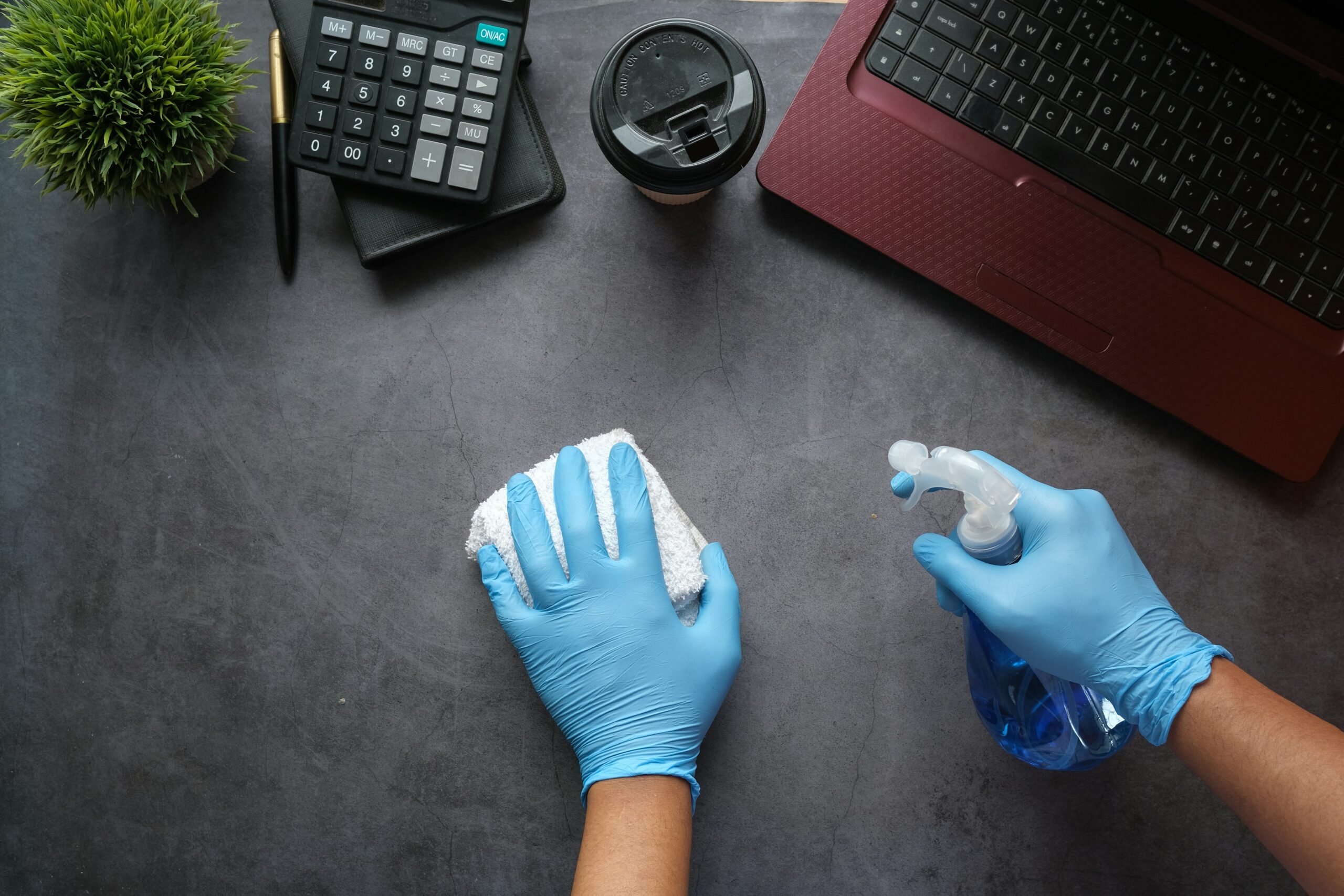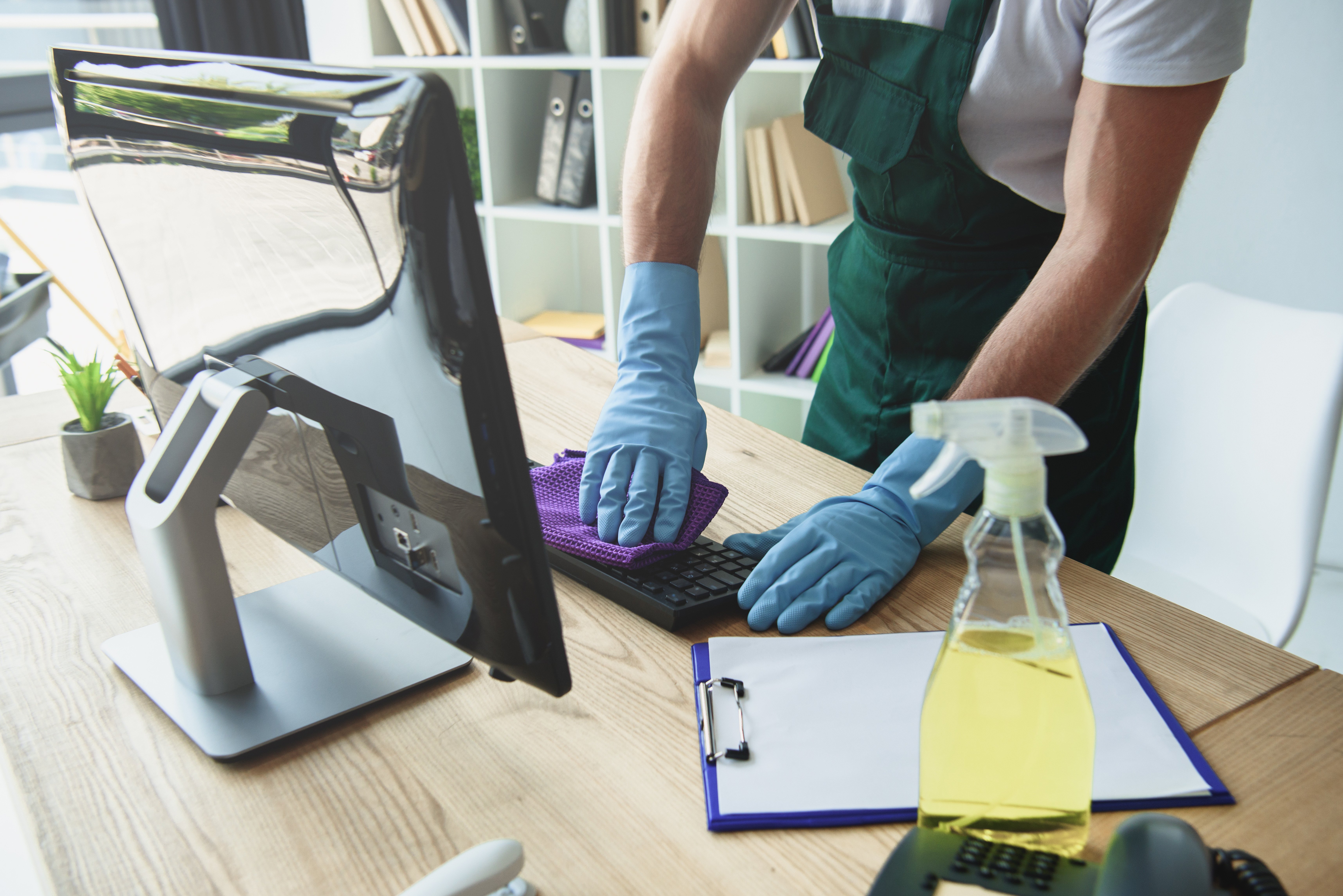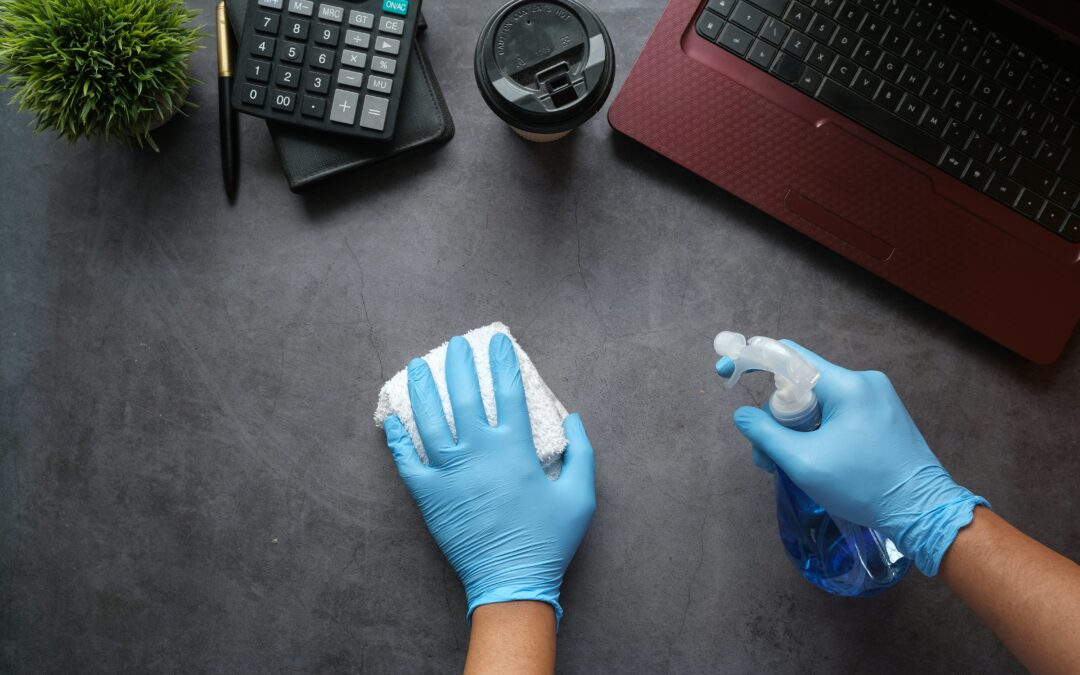
In this blog, we’ll dive into everything you need to know before you begin your office purge, so you can make your workplace the cleanest version of itself!
How do you deep clean an office?
Here is our step-by-step guide on how to clean your office:
1. Preparation
Before starting your deep clean, there is some important preparation to do beforehand to make this more than an ordinary clean.
First, clean all the clutter around your workspace. This means collecting all the unnecessary items from desks, shelves and shared spaces.
Second, declutter all the storage areas and filing cabinets, making sure to recycle and discard any unwanted material. You want to be working with clear surfaces, so use your team to ensure the office is as tidy as possible before getting started, as this is half the battle!
If you’re planning to do a specific thorough task, like deep cleaning the carpet, you will need to hire certain tools for the job in advance.
2. Gather your cleaning supplies
Before getting your hands dirty, check you have everything you’ll need for the job, because it’s annoying to start the clean only to find you’re missing something. We’ve included a handy checklist below.
If your workspace has any particular requirements, such as an offsite meeting room on a construction site, make sure you have all the additional items you’ll need to get the job done, like extension cables or a cordless vacuum if no power source is available.
3. The office cleaning process
Dusting and wiping
With any space or size, the best place to start is dusting and wiping all surfaces. This allows all the dust, grime and dirt to either be collected by your cloth or fall onto the floor, which will be picked up in later steps.
When dusting, consider everywhere and anywhere dust could be hiding. This includes, desks, shelves, furniture, outlets, appliances, door frames and even those easy to miss areas, like light fixtures, ceiling fans, the tops of doors and blinds.
This step is particularly crucial for workplaces that naturally collect a lot of dust, such as workshops, as doing this properly will have a huge impact on your workplace hygiene and long-term employee health.
Polish is a great additional consideration, but is not always necessary and can damage certain surfaces, so use with caution.
Once complete, take particular care around people’s tech, which often requires a special cleaning solution to prevent any water damage to the equipment. Using this solution and a lint-free cloth, which prevents electrostatic discharge and damage to your electronics, clean down computer monitors, phones, mice and keyboards which are often the most germ-ridden place in an office.
Once complete and as a final step, disinfect all the surfaces, while avoiding electronic devices or appliances. This will make your workspace not only clean, but hygienic.

Cleaning additional rooms
Don’t move on to cleaning the floors, until you’ve done this process throughout all rooms in the workplace.
Kitchens and break rooms, for example, will often have remnants of food and drink, so will require a firmer hand when wiping down with a kitchen cleaning spray to clean all watermarks and stains. Be sure to also empty and clean any microwaves, refrigerators and dishwashers, taking time to move and clean in behind these appliances as well. As a final step, take out the rubbish and recycling at this point, so it doesn’t ruin your lovely clean floors later down the line.
The same can be said for bathrooms, which is best addressed before cleaning the floors. We recommend using gloves and dedicated dusters or cloths with an antibacterial bathroom spray for this section, to ensure bathroom germs are not spread throughout the office. Wipe down any mirrors and surfaces, including easy-to-miss spots like the toilet’s cistern or the loo roll dispenser, and empty all the bins.
Cleaning the floor
Once all surfaces have been properly cleaned and disinfected, it’s then time to move on to the floors.
At this point, most workspaces will just call for a good vacuum throughout all rooms, collecting any dirt and debris sitting on top of the floor. Make sure to be thorough, spending time going underneath each person’s desk and furniture, and around room edges. If the job is a relatively large space, make sure your vacuum has a long enough cord and if not, use an extension cable or cordless vacuum to make sure all bases are covered.
For jobs that require additional care, especially for those cleaning their workplace as it comes to the end of their lease, this is when a carpet cleaner can also be used, helping to effectively clean years’ worth of grime out of your workplace floor.
As a final step once vacuumed, non-carpeted flooring can then be mopped using a cleaning solution appropriate for the surface. If your workplace has a hardwood floor, be sure to use a solution that doesn’t mark or damage the surface. When mopping the bathroom, try to use a separate mop and bucket if possible so bathroom germs are contained.
Glass and window cleaning
Once all other steps have been completed, the final step is taking some time to clean all glass and mirrored surfaces around the office. Leaving it until last will prevent these surfaces being dirtied when mopping or cleaning, which can leave muck, dirt and finger marks from your hard work. Use a window and glass cleaner to wipe off any residual marks on any glass or mirrored surface, with a circular motion to prevent any streaking.
For those that want to be as thorough as possible, consider doing the outside of your building’s windows too, if safely accessible. For windows that are high-up or tricky to reach, we recommend hiring a specialist to come out and finish the job.

How long does it take to deep clean an office?
The time it will take to clean an office will vary significantly depending on the size of the space. For offices of one to 10 people, a deep clean will usually take about two hours including all the rooms in the space.
For offices between 10 and 30 people, a deep clean can take as long as four to five hours, so make sure you leave enough time to get it all done.
How often should offices be deep cleaned?
Once again, this can vary significantly depending on how many people use the office and the type of business it is. For a typical small desk-based office, these spaces should be routinely cleaned between one or two times a week and deep cleaned about twice a year.
For larger desk-based offices, a regular clean should also be done one to two times a week, with a deep clean roughly four times a year.
For workplaces that will naturally accrue more dirt, such as a building site, spaces will need more frequent cleaning to be properly maintained, varying from three times a week to even every day. A deep clean should then be conducted every month or so, to ensure the space is properly maintained.
Office cleaning supplies checklist
- All-purpose cleaner
- Glass and mirror cleaner
- Disinfectant spray
- Bathroom spray
- Kitchen spray
- Polish
- Microfiber cloths
- Lint-free cloths
- Vacuum cleaner
- Mops and buckets
- Dustpan and brush
- Recyclable bin bags
- Compost caddy bin liners
- Refills
- Toilet paper
- Kitchen roll
- Paper towels
- Hand soap
- Hand sanitiser
Are you looking to deep clean your workplace? Banner has tailored solutions to ensure you are prepared to clean any workspace. Browse our catalogue or email contact.banner@BannerUK.com and the Banner team will advise you on everything you’ll need.

